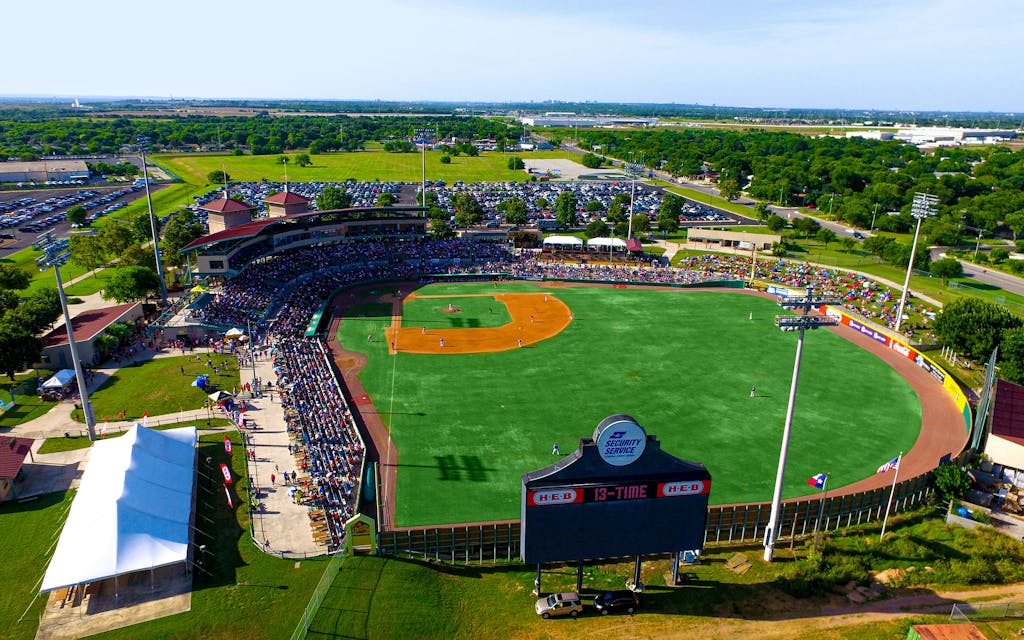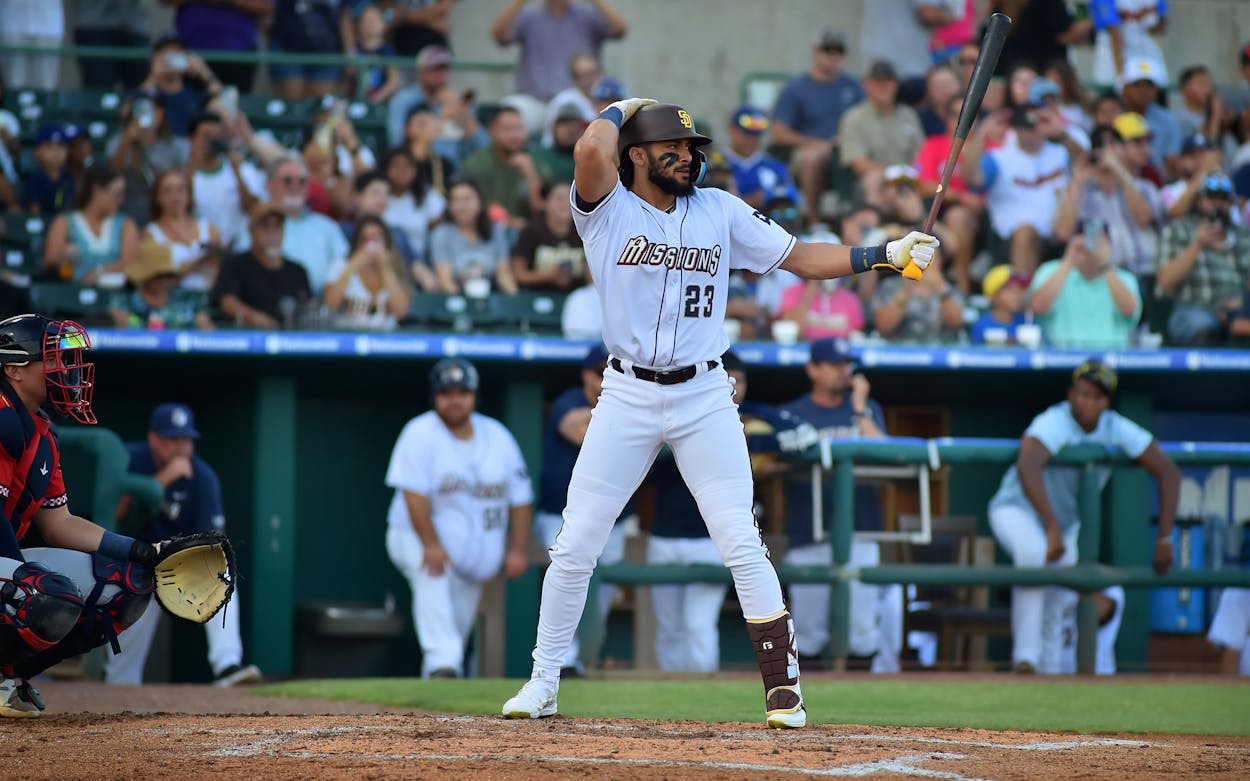“If there’s good, clean family entertainment that brings thousands of people downtown every year, night after night, we don’t care if it’s Tiddlywinks or kickball—that’s good for San Antonio.” So says Randy Smith, the San Antonio real estate developer behind a just-announced deal for a group of prominent investors to buy the San Antonio Missions minor league baseball team and, if everything works out as he hopes, build a new stadium in or near downtown.
The deal to buy the team—the double-A affiliate of the San Diego Padres—was finalized today, with Major League Baseball’s approval. (The price is reportedly $28 million, though Smith declined to comment on that.) Last week, the city approved the transfer of the lease to Nelson W. Wolff Stadium, where the Missions currently play, from the previous owner, California-based Elmore Sports Group.
The new ownership group, Designated Bidders, includes Smith, who is CEO of real estate development firm Weston Urban; his cofounder and former Rackspace chairman Graham Weston; former Texas secretary of state Hope Andrade; former San Antonio mayor Henry Cisneros; former San Antonio Spurs players David Robinson and Manu Ginóbili; Spurs board member Bruce Hill; Spurs chairman Peter J. Holt; and others. “Having local ownership is a game-changer,” Mayor Ron Nirenberg said in a statement.
Ryan Sanders Sports & Entertainment, a company run by Astros and Rangers pitching legend Nolan Ryan and his son, Reid Ryan, will be the operating partner. That company also runs the Round Rock Express, the triple-A Rangers affiliate based just a hundred miles north of San Antonio.
Smith admires the success of other cities with minor league baseball teams that have built downtown stadiums. Chief among these are the triple-A Chihuahuas of El Paso, who built their stadium back in 2014, and the Dayton Dragons of Dayton, Ohio. That team built a downtown stadium 22 years ago and have had more than 1,400 consecutive sellouts since then, a North American sports record.

Those projects hit home for Smith because he and Weston founded Weston Urban ten years ago with the intent to “help build a city that our kids will want to come home to.” While Pace Picante billionaire Kit Goldsbury was making big changes just north of downtown around the old Pearl Brewery complex, and the King William and Southtown districts on the opposite side of downtown were undergoing a creative renaissance, San Antonio’s central business district was stagnant. Other Texas cities built clusters of shiny skyscrapers for both commercial and residential use, spurring foot traffic along with restaurants and entertainment venues. Smith and Weston set their sights on emulating the best of those efforts in San Antonio.
The results are hard to miss. In addition to building towers of its own, including the crown-topped Frost Bank building and a recently started 32-floor residential tower, Weston Urban has renovated several historic office buildings and built a new downtown park. It’s a start, but Smith still sees mostly untapped opportunity to create amenities that bring San Antonians downtown to live, work, and play.
Meanwhile, the Missions’ longtime home, Wolff Stadium, built in 1994 on the far west side of the city, has begun to look more and more like a relic. Especially since Major League Baseball massively restructured the minor league system in 2020 (including eliminating 43 teams around the country), the Missions have faced increasing pressure to upgrade the facilities for players—from the locker rooms to the ball field. (The city pays 70 percent of maintenance costs, and the team pays the rest.)
While those improvements are aimed at helping the team, they do little for the roughly four thousand fans who show up for games on average (the stadium seats 6,200, plus another 3,000 on a grassy berm out past left field). And the stadium, which sits next to a major highway and is surrounded by surface parking, doesn’t allow for much interaction with the surrounding city.
For Smith, that’s the whole opportunity, the point of having a team. “The Padres pick the players. We won’t really be responsible for the product on the field,” he explains. “But what we can do is ensure the best game-day experience that San Antonio deserves.”
That means, on one hand, honoring beloved traditions such as having a young fan chase Henry the Puffy Taco, an unofficial team mascot, around the bases—or continuing to use the team’s alternate name, the Flying Chanclas (Spanish for “sandals”), for a few games a year. On the other hand, Smith argues, a great game-day experience goes beyond the stadium. “And that’s why we think it has to be centrally located.” (The San Antonio Express-News scouted a few potential locations.)
Beyond baseball, a new stadium in downtown San Antonio could be a venue for everything from concerts to charity games to Boy Scout campouts, Smith says. And for that matter, he sees the potential stadium as “one piece of the mosaic” of the wider transition of the area. UTSA’s large and growing downtown campus has been another piece of the transition, as has the construction of a new version of the River Walk, with a linear park alongside apartments and retail businesses, on long-neglected San Pedro Creek.
Smith hopes that the city’s other, much more prominent professional sports team might also one day move back downtown, from the twenty-year-old AT&T Center on the East Side. Clustering a venue for the Spurs, or some other future sports franchise, with the Missions could create a centralized sports district.
Of course, the news that Smith and his supergroup of new owners are taking over is no guarantee of a new stadium that will unlock a new urban idyll for San Antonio. For one thing, owners of sports teams often seek public funding to help pay for ballparks (comparable stadiums in recent years have cost in the neighborhood of $75 million to $100 million), and that will inevitably come with some public hand-wringing.
Despite success stories like the El Paso Chihuahuas’ $78 million Southwest University Park stadium, academic studies of publicly funded stadiums have cast doubt on whether they pay off for the community. At the very least, the debate is not settled. “Every community is different, with a broad assortment of arrows in the quiver as far as funding,” Smith says. “Our task will be to work with the community to discover what works for San Antonio.”
What’s certain is that downtown San Antonio stood still for decades, with a humming tourist trade concentrated around the Alamo, the convention center, and the River Walk—and little else there but offices. Smith and Weston’s work in the past decade has begun to change that and create new street life and experiences for locals. A stadium for a storied local institution—especially one connected to its surroundings and not an island in a sea of asphalt—would continue that positive trend.
The Missions will play at Wolff Stadium for at least the next two years, Smith says, but fans will start to see changes to the experience “right away,” thanks to the Ryans’ crew. “They will bring what they do so well in Round Rock, creating a family experience, and apply it in San Antonio.”
The Missions have been around since 1888. They were one of the charter teams of the Texas League, and they’ve never left the Alamo City. “And that is so cool,” Smith says, with an earnest sports geek’s awe, as well as an acknowledgement of the new owners’ responsibility to do right by the city. This isn’t Tiddlywinks. “I say this about the historic buildings we renovate: You never feel like you own that. You are just the next steward.”
- More About:
- Sports
- Business
- San Antonio








